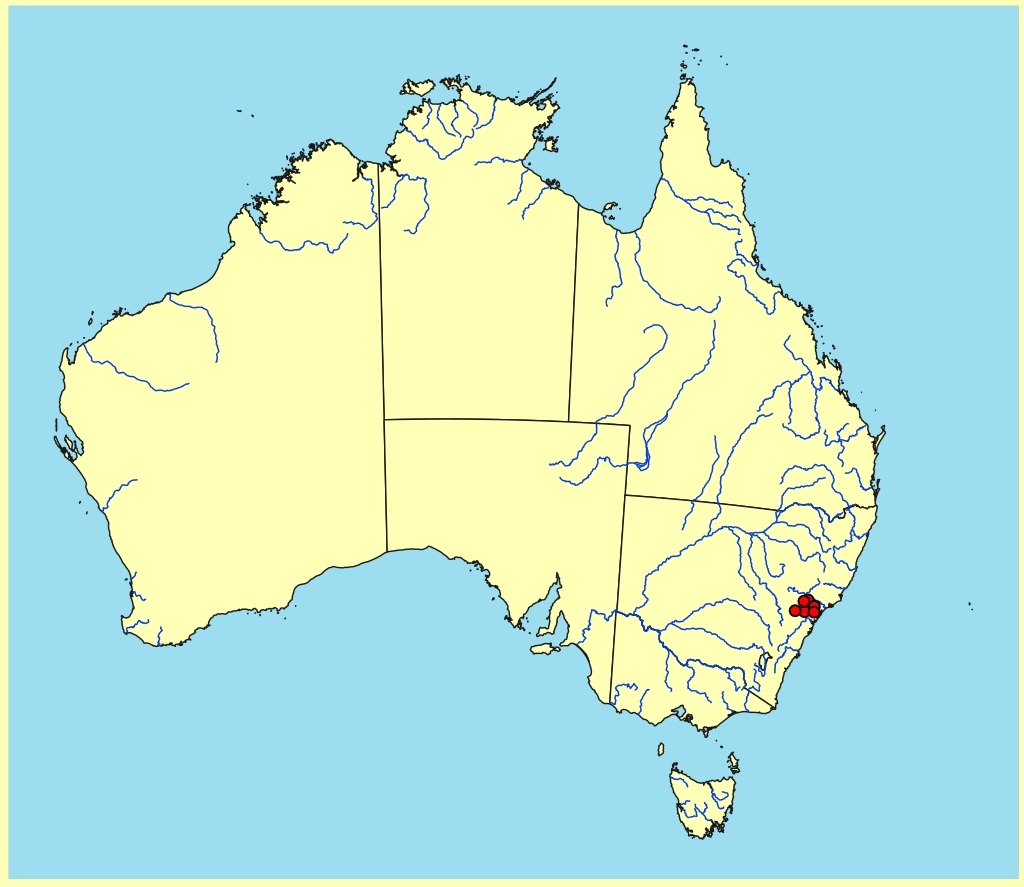Eucalyptus | Eucalyptus | Capillulus | Pachyphloius
Euclid - Online edition
Eucalyptus expressa
Eucalyptus expressa S.A.J. Bell & D. Nicolle, Telopea 14: 69-73 (2012).
T: New South Wales: Central Coast: Parsons Creek, alongside Putty Road, 14.4 km south-west of Bulga, 32º45'07"S, 150º55'22"E, D. Nicolle 5265 & S.A.J. Bell, 30 January 2009; (holotype: AD; isotype: CANB NSW BRI [note CANB isotype not received 27 November 2019]).
Tree to 40 m tall. Forming a lignotuber.
Bark rough throughout extending to branches ca 5 cm diameter, stringy, brownish grey.
Branchlets not glaucous; lacking oil glands in the pith.
Juvenile growth (coppice or field seedlings to 50 cm): stems round in cross-section, stellate hairy; juvenile leaves petiolate, opposite for few nodes soon becoming alternate, ovate, no dimension data available, bases tapering or becoming oblique, margin weakly indented, apex pointed, discolorous, darker green on upper side.
Adult leaves alternate, petiole 0.8–1.5 cm long; blade lanceolate or falcate, 9–16 cm long, 1.8–4.8 cm wide, base tapering or oblique, margin weakly indented due to lenticel-like structures, apex pointed, lamina thin-textured, concolorous, glossy green, side-veins acute, sparsely reticulate, intramarginal vein present, oil glands irregular, island.
Inflorescence axillary unbranched, peduncles 0.7–1.5 cm long, angular-terete or only slightly flattened, buds 7 to ?24 per umbel, pedicellate (pedicels angular 0.1–0.4 cm long). Mature buds buds fusiform, 0.5–0.7 cm long, 0.2–0.3 cm wide, yellowish, smooth, scar absent, operculum conical to beaked (as long as to longer than hypanthium), stamens irregularly flexed, anthers reniform to cordate, versatile, dorsifixed, dehiscing by confluent slits, style long, stigma blunt, locules 3 or 4, the placentae each with 2 vertical ovule rows. Flowers white.
Fruit pedicellate (pedicels 0.1–0.4 cm long), hemispherical to truncate-globose, 0.35–0.5 cm long, 0.5–0.8 cm wide, disc usually level, valves 3 or 4, very strongly exserted.
Seeds dark brown to blackish, 1–2 mm long, pyramidal or obliquely pyramidal, dorsal surface smooth, hilum terminal.
Cultivated seedlings (measured at ca node 10): not grown (data from Bell & Nicolle (ibid.)); cotyledons reniform; stems rounded in cross-section, densely hairy with stellate hairs; leaves opposite for 1 to 3 pairs then alternate, petiolate, ovate, 5–8.5 cm long, 2–4 cm wide, more or less undulate, base usually oblique, margin weakly indented, apex elongate acute, discolorous, green, densely hairy with stellate hairs.
Flowering has been noted in October and November.
A tall forest stringybark tree endemic to New South Wales where restricted to an area of the Central Coast region and the adjacent area of the North Coast region, north and north-west of Sydney in Yengo National Park, the east of Wollemi National Park and in Pokolbin State Forest. Its habitat is sheltered sites in sandstone country with deeper loamy and clay-loam soils. Bark is brownish grey to grey, crown green to dark green with thin-textured concolorous or slightly discolorous leaves with conspicuously dentate margins, small fusiform buds and hemispherical fruit with level disc and obviously exserted valves. Juvenile growth (coppice) is stellate hairy.
Eucalyptus expressa had previously been included in E. eugenioides but is now regarded as a distinct species. It is distinguished from E. eugenioides by the prominently exserted fruit valves, lenticel-like structures on the adult leaf margin and more sheltered habitat; E. eugenioides has fruit with valves at about rim level, usually lacks lenticel-like structures on its thin-textured crown leaves.
The only other stringybark tree species likely to be confused with E. expressa in its region of occurrence is E. sparsifolia which has similar shaped buds, but is distinguished by clusters of sessile fruit with slightly raised disc and valve-tips at rim level or enclosed, and it also has narrower crown leaves with an entire margin. E. sparsifolia prefers drier sites. Other stringybark species in this area, E. prominula, E. bensonii and E. agglomerata, have larger thicker-textured crown leaves and larger buds and fruit.
The prominently exserted valves of the fruit of Eucalyptus expressa were, according to annotations on earlier collected specimens, regarded as style abnormalities due to ?parasitism (NSW324703, NSW324707). Recent dissection of fresh buds shows that the style is thickened for ca one quarter of its length just above the ovary roof, and observation of spent flowers shows the style breaks off where this tapers down thus leaving a stub – persistence of this stub accounts for the exaggerated valve length consistently seen in the fruit. The thickened portion of the style did not appear parasitized by invertebrate larvae but may of course harbour insect eggs or be infected by other life-forms (CANB905549, N. England s.n. from type locality - fresh spent flowers of this collection showed patchy red blushes over green on the thickened lower style) fide Andrew Slee.
MORE ABOUT STRINGYBARKS






